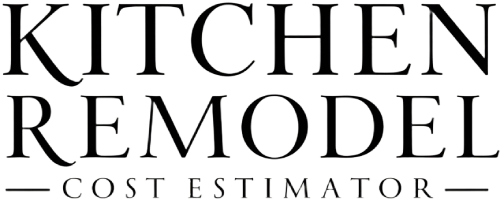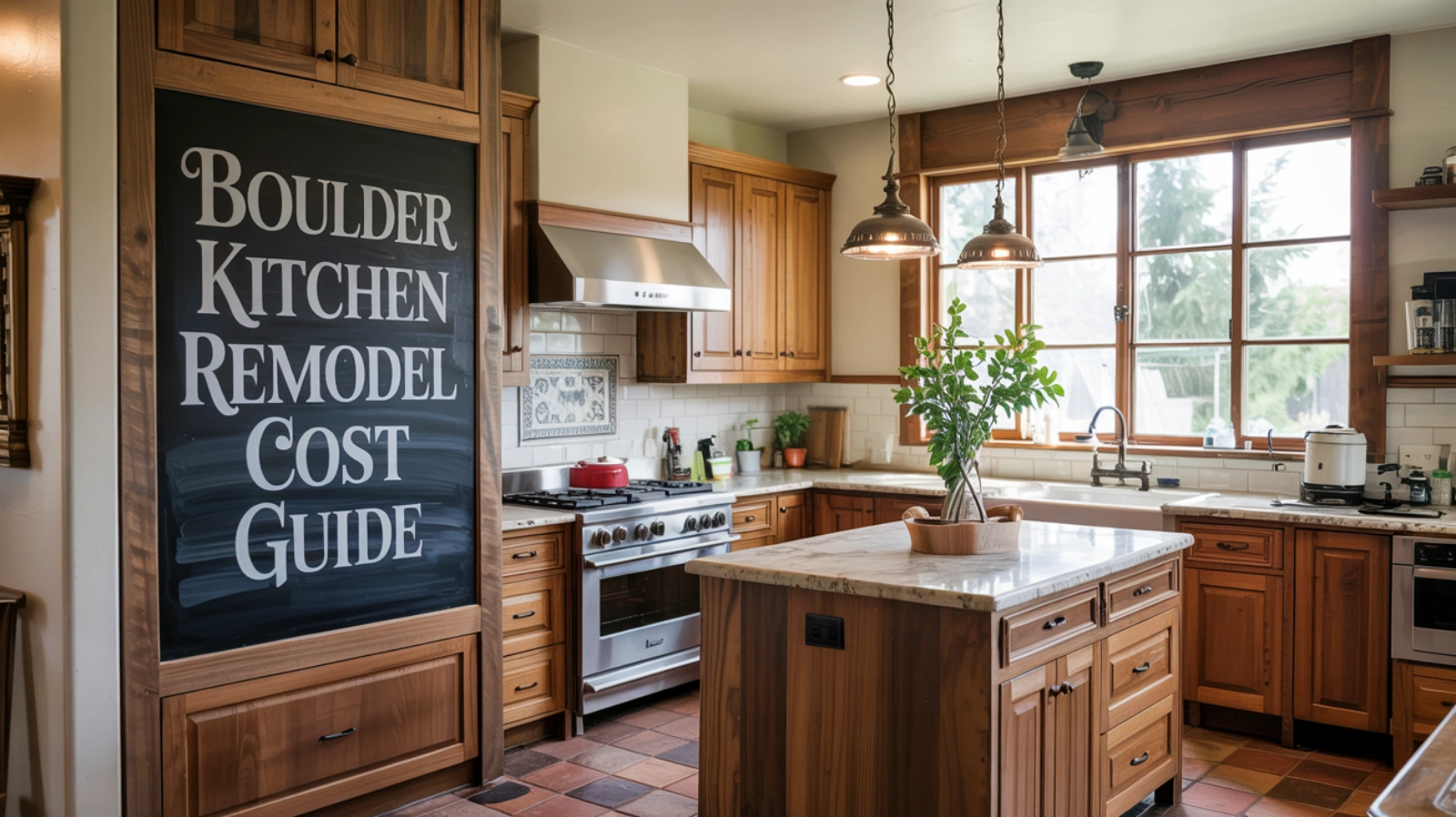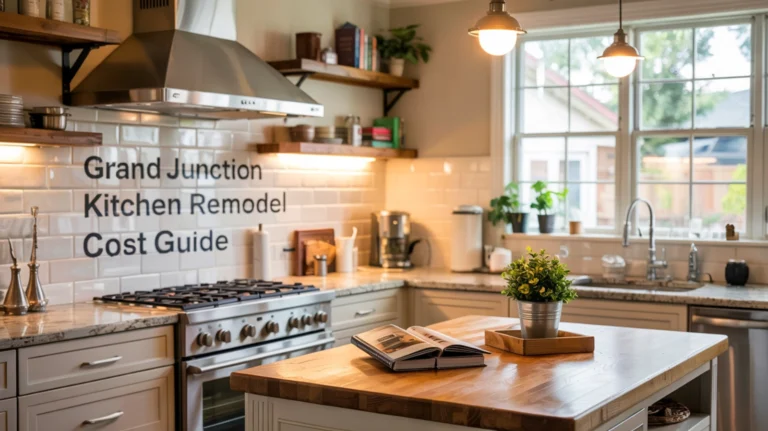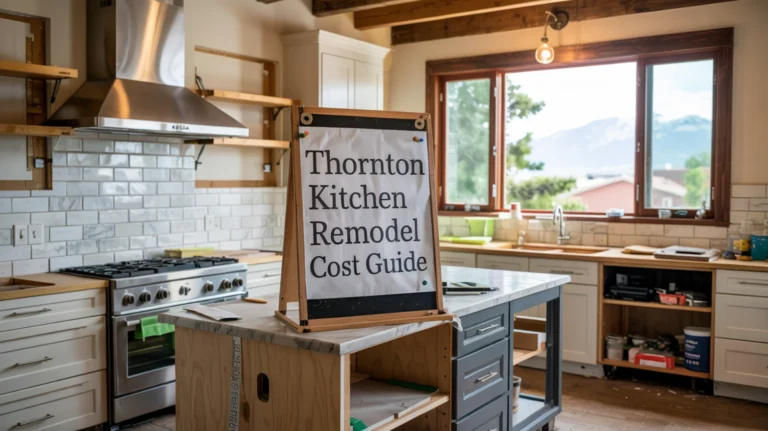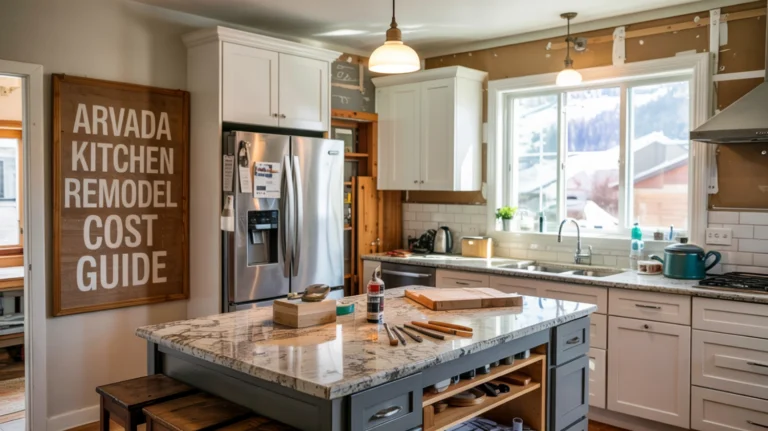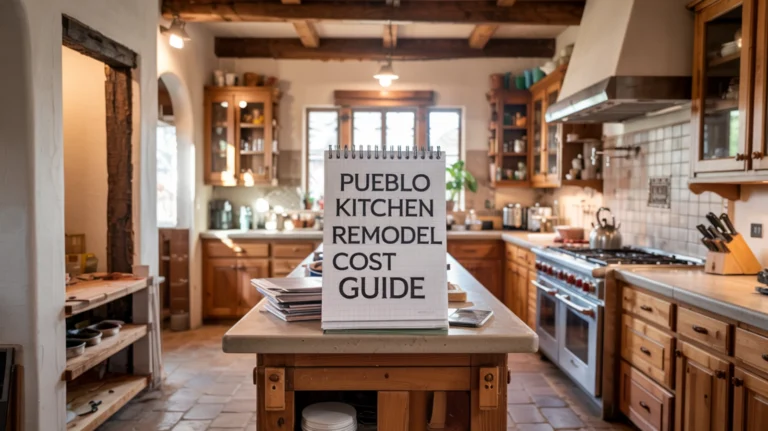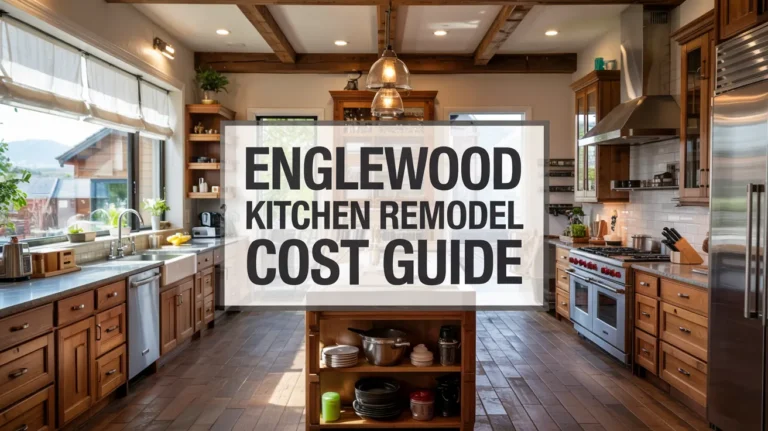Boulder’s kitchen remodel market plays by different rules than neighboring cities. Our unique blend of high property values, strict permitting, and sustainability focus creates a distinctive renovation landscape where material choices and design decisions dramatically impact both aesthetics and investment returns.
So what will that dream kitchen actually cost you in Boulder County?
The average kitchen remodel cost in Boulder, Colorado ranges from $25,000 to $70,000. Entry-level remodels may cost around $20,000, while upscale renovations with designer finishes, custom cabinetry, and layout changes can exceed $100,000 due to higher labor and material costs in the area.
Kitchen Remodel Cost Estimator for Boulder
Boulder Kitchen Remodel Cost Calculator
Get an estimate for your kitchen renovation based on your specifications.
Estimated Kitchen Remodel Cost
This estimate is based on national averages and may vary based on your location, material availability, contractor rates, and other factors. Prices are estimates only and should be used for planning purposes.
Looking for more accurate costs in your area? Search for location-specific remodel costs.
Boulder Kitchen Remodel Cost Analysis and Benchmarks

“How much will my Boulder kitchen remodel cost?” It’s probably the first question you’re asking, and honestly, it’s complicated.
Why? Because kitchen costs in Boulder don’t just vary—they dance across a spectrum that might make your head spin.
Let’s break down those numbers by square foot first. In Boulder and the broader Denver area, renovation costs reflect not just the physical space, but what you’re putting into it.
General Colorado renovation estimates typically fall between $150 and $350 per square foot. Some Denver figures suggest rates as low as $15 to $60 per square foot, but don’t get too excited—those numbers usually represent basic, less intensive work.
When we zero in on kitchens specifically, the numbers climb. National kitchen estimates typically run $75 to $250 per square foot, sometimes reaching $400 for high-end finishes.
But Boulder? That’s another story entirely.
Denver kitchen remodels typically cost $190 to $375 per square foot, while Boulder’s premium market pushes that envelope to $500 to $700 per square foot for upscale renovations. Yes, you read that right.
Square footage isn’t even the most reliable metric for your kitchen budget. Why not? Because kitchens pack expensive components—custom cabinets, professional appliances, stone countertops—into relatively small spaces.
The cost of these elements doesn’t scale linearly with your kitchen’s footprint. That’s why we see such dramatic ranges: from basic cosmetic updates at $15 per square foot to luxury Boulder renovations exceeding $650.
What’s behind those top-tier prices? Beyond materials and standard labor, luxury Boulder remodels often include premium architects, complex structural changes, and integrated technology systems.
For practical budgeting, let’s forget square footage for a moment. Instead, thinking about your project scope—minor, mid-range, or upscale—gives you a much clearer financial picture.
Project Costs by Remodel Scale
Kitchen renovations fall into three distinct categories, and understanding which one fits your vision makes all the difference in setting a realistic budget. Let’s explore what each level actually means in Boulder.
Minor Kitchen Remodel
Think of a minor remodel as a refresh rather than a reinvention. You’re keeping the existing layout but giving everything a facelift.
What does that include? Cabinet refacing or painting, new entry-level countertops, updated appliances, a fresh sink and faucet, new flooring, and paint.
The bones of your kitchen stay put, but the aesthetic transforms completely.
Mid-Range Kitchen Remodel
Mid-range remodels kick things up several notches. Now you’re replacing major components and possibly tweaking the layout.
You’re looking at new stock or semi-custom cabinetry that fits your space perfectly. Granite or quartz countertops replace laminate or tile. Stainless steel appliances, updated flooring, and improved lighting fixtures all enter the picture.
The kitchen still occupies the same footprint, but functionality and finishes improve dramatically.
Upscale Kitchen Remodel
This is where dreams meet reality—for a price. Upscale remodels involve substantial changes and premium everything.
Walls move. Custom cabinetry replaces stock options. Countertops feature marble, high-grade quartz, or exotic granite that makes guests wonder if they should remove their shoes.
Commercial-grade or integrated appliances, designer lighting schemes, custom tile work, and high-end flooring complete the transformation. Your kitchen doesn’t just look different—it’s fundamentally reimagined.
So what do these categories cost in Boulder? Brace yourself.
While national estimates for minor remodels range from $1,000 to $25,000, Boulder’s starting point is higher. Expect to invest $20,000 to $35,000 for even a “minor” update.
Mid-range renovations nationally span $25,000 to $60,000, but in Boulder, they commonly range from $60,000 to $150,000. That’s not a typo.
Why such premium prices? Boulder’s combination of high property values, elevated labor costs, and sophisticated material preferences creates a perfect storm for remodeling budgets.
Boulder Kitchen Remodel Costs by Scale
| Scale | Key Features | Estimated Boulder Cost Range ($) | Estimated Cost Per Sq Ft Range ($) |
|---|---|---|---|
| Minor | Cosmetic updates: Cabinet refacing/painting, entry/mid countertops, updated appliances, new sink/faucet, flooring, paint; existing layout retained. | $20,000 – $35,000 | $150 – $250 |
| Mid-Range | Component replacement: Stock/semi-custom cabinets, granite/quartz counters, mid-grade appliances, flooring, lighting; potential minor layout changes. | $60,000 – $150,000 | $250 – $450 |
| Upscale | Significant changes: Custom cabinets, premium counters (marble/quartz), high-end appliances, designer lighting, custom backsplash, high-end flooring, major layout/structural changes. | $150,000 – $300,000+ | $450 – $700+ |
Note: These ranges reflect typical Boulder market costs as of 2024. Your actual costs will vary based on your home’s specific conditions and your material selections.
Cost Relative to Home Value
Ever heard that kitchen renovation budgets should be a percentage of your home’s value? There’s wisdom in that approach, especially in Boulder’s unique market.
Most designers and realtors suggest allocating between 10% and 15% of your home’s total market value for a kitchen renovation. Some sources suggest a broader range—anywhere from 5% to 20%, depending on how central the kitchen is to your lifestyle.
In Boulder specifically, local experts often recommend the 10% guideline, with a minimum investment threshold of $60,000. That might sound high, but consider the context.
With Boulder’s median home prices exceeding $1 million, the math gets interesting quickly. A modest 10% of that million-dollar home yields a $100,000 kitchen budget—which lands you squarely in mid-range remodel territory by local standards.
The percentage approach helps prevent the classic remodeling pitfall: over-improving for your neighborhood. You don’t want to invest $200,000 in a kitchen when your home value and location can’t support recouping that investment.
But here’s where Boulder homeowners need to be careful. The high property values can create a false sense of security.
Just because your home is worth $1.5 million doesn’t mean spending $225,000 (15%) on your kitchen will yield proportional returns. Financial data consistently shows diminishing returns for major upscale projects, regardless of market.
Think of it this way: The percentage rule helps you set an appropriate ceiling for your budget based on your home’s value tier. It doesn’t guarantee you’ll recoup that percentage when you sell.
Many Boulder homeowners misinterpret this guideline and splurge on highly personalized features—a $15,000 custom range hood or $25,000 in hand-painted imported tiles—assuming their home’s high value ensures they’ll get that money back.
The reality? While the percentage approach helps establish a reasonable budget cap, your actual return depends more on the choices you make within that budget. Focusing on widely appealing updates rather than hyper-personalized luxury typically yields better financial returns.
Use the percentage rule as your starting point—just don’t expect it to be your financial safety net for every design decision you make.
Return on Investment Analysis
Let’s talk about what really matters when you’re investing serious money in your kitchen: what will you get back when you sell?
The numbers tell an interesting story that might surprise you.
ROI by Remodel Scale
Not all kitchen investments are created equal when it comes to return on investment. The scale of your project dramatically affects how much of your money you’ll recoup.
%%{init: {'theme': 'neutral'}}%%
graph TD
A[Remodel Scale] --> B(Minor);
A --> C(Mid-Range);
A --> D(Upscale);
B --> B1{ROI: 90%+};
C --> C1{ROI: 45-75%};
D --> D1{ROI: 35-55%};
style A fill:#f9f,stroke:#333,stroke-width:2px
style B fill:#ccf,stroke:#333,stroke-width:1.5px
style C fill:#ffcc99,stroke:#333,stroke-width:1.5px
style D fill:#ccffcc,stroke:#333,stroke-width:1.5px
style B1 fill:#FFFFE0,stroke:#333,stroke-width:1.5px
style C1 fill:#FFFFE0,stroke:#333,stroke-width:1.5px
style D1 fill:#FFFFE0,stroke:#333,stroke-width:1.5pxMinor Kitchen Remodels consistently offer the highest ROI percentages. In the Denver/Boulder region, these cosmetic updates often return nearly all your investment, with recoupment figures between 96-99%. National averages are somewhat lower at 80-81%.
Even with recent market shifts, minor remodels still return 54-71% according to the latest local analyses. That’s significantly better than larger projects.
Why such strong returns? Because minor remodels hit the sweet spot between visual impact and buyer value. Fresh cabinet faces, new countertops, and updated appliances create that “move-in ready” appeal without the hefty price tag of structural changes.
Mid-Range/Major Kitchen Remodels show a substantial drop in ROI. Denver estimates range from 49% to 75% for these more extensive projects. A 2024 local estimate for major remodels with layout changes sat at just 51%.
That means for every $100,000 you spend, you might only recoup $51,000 at sale time. Not exactly the investment return you’d hope for.
Upscale/Luxury Kitchen Remodels yield the lowest percentage returns despite adding the highest absolute dollar value to your home. Denver estimates place luxury kitchen ROI at just 38%, while national averages hover between 54-60%.
Boulder-specific sources suggest somewhat higher returns of 84%, but this appears to be an outlier compared to most market data. A more realistic expectation for upscale projects falls between 35-55%.
The pattern is crystal clear: less expensive, minor kitchen updates focusing on cosmetic improvements provide the most favorable financial return when you sell your Boulder home.
While extensive mid-range and upscale remodels add more absolute dollar value, a substantially smaller fraction of their higher initial cost comes back to you.
Kitchen Remodel ROI by Scale (Boulder/Denver Area)
| Scale | Typical Boulder Cost Range ($) | Estimated Cost Recouped (ROI %) | Notes |
|---|---|---|---|
| Minor | $20,000 – $35,000 | 90% + | Highest ROI, focuses on cosmetic updates. Recoupment near 96-99% reported in some local studies. |
| Mid-Range | $60,000 – $150,000 | 45% – 75% | Significant drop in ROI. Involves replacing major components, possible minor layout changes. |
| Major / Upscale | $150,000 – $300,000+ | 35% – 55% | Lowest ROI percentage despite highest absolute value increase. Involves custom work, high-end materials, layout changes. |
ROI percentages come from various sources including Cost vs. Value reports and local market analyses. Actual returns depend on specific choices, market conditions at sale time, and quality of execution.
Factors Influencing ROI
Want to maximize your kitchen investment returns? The difference between recouping 90% versus 40% of your costs often comes down to several key strategic decisions.
Scope and Scale matters enormously. As we’ve seen, minor remodels focusing on cost-effective updates consistently outperform major renovations in percentage returns. The sweet spot appears to be updates that transform appearance without moving walls or requiring extensive structural changes.
Why such dramatic differences? Think about buyer psychology. Most buyers want an updated kitchen, but they also want to feel like they’re getting value. A $30,000 refresh that looks amazing offers better perceived value than a $200,000 custom renovation where much of the cost is invisible (like moving gas lines or reinforcing floor joists).
Material Quality creates a fascinating balancing act. While high-quality finishes attract buyers, using excessively expensive or highly niche materials often backfires financially.
For example, spending $15,000 on exotic granite counters rather than $5,000 on popular quartz might satisfy your personal aesthetic but won’t necessarily return that extra $10,000 at sale time.
The highest returns typically come from durable, mid-range options that appeal to a broad audience. Think quality, semi-custom cabinets rather than fully custom, and quartz or quartzite countertops instead of rare natural stones or concrete.
Local Market Dynamics play a huge role in Boulder specifically. In this competitive market, even relatively minor kitchen updates can significantly boost marketability and value. Boulder homes with renovated kitchens generally sell faster than those needing updates—sometimes dramatically so.
What’s particularly interesting is how Boulder’s market elevates certain features. Energy-efficient appliances and sustainable materials often command premium returns here compared to other markets, reflecting local environmental values.
Project Execution and Functionality form another critical piece. High-quality craftsmanship and proper building code compliance aren’t just legal requirements—they’re financial necessities.
Beyond basic execution, focusing on functional improvements like optimized storage solutions and effective lighting plans enhances the kitchen’s appeal. These practical upgrades often yield stronger returns than purely aesthetic splurges.
Target Buyer Appeal might be the most overlooked factor. To maximize ROI, renovations should appeal to a broad segment of potential buyers.
Highly personalized designs or niche features—like a built-in espresso station or specialized wok kitchen—might be your personal dream but can actually limit your pool of interested buyers and negatively impact resale value.
Simple, cost-effective upgrades like replacing dated cabinet hardware can offer surprisingly good returns by enhancing appeal with minimal investment.
The through-line in all these factors? Strategic moderation. Avoiding both under-investment (which leaves the kitchen feeling dated) and over-investment in materials or designs that are too costly or specific typically yields the strongest financial returns.
While mimicking high-end luxury trends might satisfy your Pinterest board, a well-executed mid-range update that effectively modernizes the space without venturing into diminishing returns territory makes the most financial sense.
Kitchen Remodel Cost Allocation
Ever wonder where all that renovation money actually goes? Understanding the typical breakdown helps you budget strategically and identify where you might splurge or save.
Typical Budget Breakdown
Analyzing cost distributions reveals a consistent pattern across kitchen remodels. Cabinetry consistently emerges as the budget beast, followed by installation/labor and appliances.
While exact percentages vary slightly between projects, the relative distribution stays remarkably consistent:
One typical breakdown puts cabinets at 29%, installation and labor at 17%, appliances and ventilation at 14%, countertops at 10%, flooring at 7%, lighting at 5%, backsplash at 5%, walls and ceilings at 5%, doors and windows at 4%, and faucets and plumbing at 4%.
Another analysis shows cabinets at 29%, labor costs at 17%, appliances at 14%, countertops at 10%, plumbing at 6%, flooring at 5%, lighting and electrical at 5%, backsplash at 5%, doors and windows at 4%, and miscellaneous at 5%.
See the pattern? Cabinets consistently command around 30% of the budget, making them the single most expensive element in nearly every kitchen remodel.
This distribution reveals something crucial: decisions about cabinetry—choosing between stock, semi-custom, custom, or refacing—impact your bottom line more than any other single choice.
Labor represents another substantial chunk, particularly relevant in Boulder’s high-cost labor market. The combination of these two factors—cabinets and labor—already accounts for nearly half your budget before you’ve even chosen appliances or countertops.
What’s interesting are the relatively smaller percentages allocated to elements that can make outsized visual impacts. The backsplash at around 5%, lighting at around 5%, and faucets/plumbing at around 4% offer opportunities for strategic spending.
These smaller-ticket items can provide significant aesthetic or functional improvements without drastically inflating your total project cost. For example, a statement backsplash or distinctive lighting fixtures might deliver more design bang-for-buck than premium cabinet upgrades.
This insight suggests a potential strategy: concentrating design flair within these lower-percentage categories while making more practical, cost-effective choices for the big-ticket items like cabinets and appliances.
Typical Kitchen Remodel Cost Breakdown (%)
| Component | Typical Budget Allocation (%) | Notes |
|---|---|---|
| Cabinets | 29% – 30% | Consistently the largest single expense. |
| Labor / Installation | 17% – 30%+ | Significant cost; percentage may vary based on definition (GC only vs. all trades). |
| Appliances & Ventilation | 14% | Major cost center, wide range in actual spending. |
| Countertops | 10% – 20% | Varies significantly with material choice (e.g., laminate vs. premium quartz). |
| Flooring | 5% – 15% | Depends on material and area size. |
| Lighting | 5% | Includes fixtures and potentially electrical labor. |
| Plumbing & Faucets | 4% – 6% | Includes fixtures and potentially plumbing labor. |
| Backsplash | 5% | Material and installation. |
| Other (Walls, Doors, Misc.) | 5% – 9% | Includes paint, drywall, windows, permits, miscellaneous items. |
Percentages represent approximate averages. Your actual distribution will vary based on project scope, material choices, and labor costs.
Labor vs. Material Costs
How much of your budget goes to stuff versus the people installing that stuff? The answer varies, but understanding the breakdown helps you identify potential savings opportunities.
Estimates regarding the division between labor and materials show some interesting variation. Several sources suggest materials constitute the larger portion, with ratios cited as approximately 60% materials to 40% labor, or even 67-70% materials to 30-33% labor.
However, detailed percentage breakdowns sometimes list “Installation/Labor” as a smaller component, around 17%. What explains this apparent contradiction?
The discrepancy likely stems from differing definitions of “labor.” The lower 17% figure might represent only the general contractor’s direct installation labor, while the higher 30-40% range encompasses all labor involved—including specialized tradespeople like electricians, plumbers, and tile installers, plus potential design fees.
Given Boulder’s documented high labor rates, the higher proportion (30-40% of total project cost) likely provides a more realistic picture for comprehensive kitchen remodels involving multiple trades.
This substantial labor allocation has significant implications in Boulder’s high-wage market. It means that project complexity, which requires more specialized trades or longer hours, and increases in project scope, which demand more overall labor time, will disproportionately drive up costs compared to material upgrades alone.
This dynamic highlights potential savings through strategic DIY efforts on appropriate tasks. Painting, minor demolition, or installing cabinet hardware yourself can directly reduce one of your most significant cost components, making certain remodel types more financially accessible.
However, proceed with caution. DIY work on permitted elements (electrical, plumbing, structural) can create complications with inspections and insurance. Save your DIY efforts for truly cosmetic elements where mistakes won’t compromise safety or code compliance.
Common Materials: Costs and Performance
Let’s talk about what you’ll actually be living with after the dust settles. Material choices dramatically impact not just your budget but how your kitchen looks, functions, and holds up over time.
Countertops

Your countertops might represent only 10-20% of your budget, but they’re 90% of what catches the eye. They’re also where you’ll chop, spill, place hot pans, and live daily life.
So what are Boulder homeowners choosing, and why?
Quartz reigns supreme in many Boulder kitchens, and for good reason. This engineered stone blends natural quartz with polymer resins to create surfaces that are practically bulletproof. Non-porous? Check. Stain-resistant? Absolutely. Available in endless colors and patterns? You bet.
Expect to pay between $55 and $155 per square foot installed. Total countertop costs typically reach $12,000 depending on your kitchen size and the specific product you select.
Industry insiders measure quartz quality through standards like ASTM C97, which tests water absorption (good quartz is <0.02%). For strength, look for products exceeding 30,000 psi in compressive strength tests (ASTM C170) and 7,000 psi in flexural strength (ASTM C880).
Granite remains a classic choice, cherished for its natural beauty and excellent durability. Each slab tells a geological story, with unique patterns formed over millions of years.
Costs range from $40 to $100 per square foot installed, making some granite varieties surprisingly affordable. High-quality granite should have density greater than 160 lb/ft³ and water absorption less than 0.40%.
Unlike quartz, granite requires periodic sealing to maintain its stain resistance. But for many homeowners, the natural variation and depth make this minor maintenance worthwhile.
Marble offers unmatched luxury and visual elegance with its distinctive veining. It’s the countertop equivalent of a sports car—beautiful but temperamental.
Plan to spend between $60 and $100 per square foot installed. Why the premium? Each slab is a unique work of natural art, formed through incredible geological processes.
The tradeoff? Marble is considerably more porous than granite or quartz, making it susceptible to etching from acidic foods and staining from red wine. It’s gorgeous but high-maintenance.
Butcher Block brings warmth and organic character to your kitchen. Made from wood—often maple, walnut, or oak—these countertops range from $30 to $100 per square foot.
Beyond aesthetics, butcher block offers functional benefits for cooking enthusiasts. You can chop directly on the surface (though dedicated cutting boards are still recommended to prevent excessive wear).
Quartzite (not to be confused with quartz) is a natural metamorphic rock that offers marble-like appearance with granite-like durability. It’s increasingly popular in high-end Boulder kitchens.
Expect to pay between $60 and $120 per square foot installed. What makes it special? Quartzite combines the stunning visual depth of marble with significantly better resistance to staining and etching.
Other options like tile ($480-$4,340 total), laminate (starting around $20 per square foot), and concrete or recycled glass countertops each have their place in the market, often serving budget-conscious remodels.
Material selection represents a pivotal decision that influences both your project’s cost and your kitchen’s long-term usability. Industry standards like ASTM tests provide objective comparisons beyond subjective appearance or marketing claims.
Remember: the quality of fabrication and installation matters just as much as the material itself. Tight seams, properly supported overhangs, and expertly polished edges transform even mid-grade materials into stunning finished products.
Cabinets
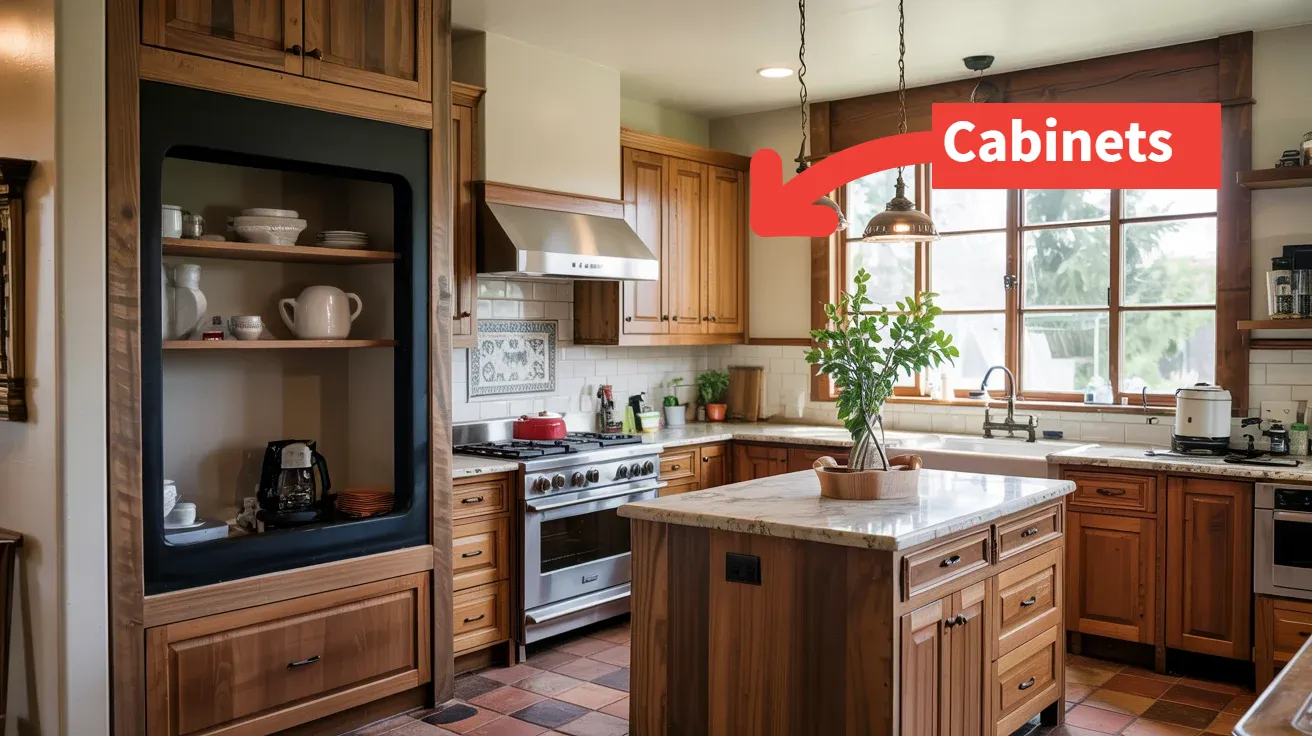
There’s a reason cabinets devour 29-30% of your kitchen budget. They dominate visually, determine functionality, and set the tone for your entire space. Let’s decode your options.
Stock Cabinets represent your entry-level choice. These are pre-manufactured in standard sizes with limited style and finish options. Think of them as the “off-the-rack” suits of the cabinet world—they’ll do the job, but the fit and details won’t be customized.
Costs typically run $60 to $200 per linear foot, though some sources cite ranges up to $300 per linear foot. These cabinets arrive fastest and install with minimal fuss, making them popular for minor remodels and rental properties.
Semi-Custom Cabinets offer the perfect middle ground for many homeowners. They use stock cabinet boxes but provide significantly more options for finishes, door styles, and modifications. Need that cabinet two inches narrower? No problem. Want specialized storage inserts? You got it.
Expect to pay $100 to $500 per linear foot. These cabinets strike a balance between personalization and budget, making them a common choice for mid-range remodels. Brands like Medallion and Design-Craft fall into this category.
Custom Cabinets are built specifically for your kitchen—down to the millimeter. They offer maximum flexibility in design, size, materials, and features. If you’ve dreamed it, a custom cabinet maker can probably build it.
This premium approach comes with premium pricing: $500 to $1,200 per linear foot. Some sources suggest ranges as wide as $100 to $1,200 per linear foot depending on complexity, materials, and craftsmanship.
Cabinet Refacing deserves serious consideration if your existing cabinet boxes are in good condition. This process updates the exterior appearance by replacing doors, drawer fronts, and hardware, and applying new veneer to the visible cabinet frames.
With average costs around $6,925, refacing delivers a fresh look for roughly 40-50% of full replacement costs. It’s environmentally friendly too, reducing landfill waste significantly.
Cabinet Painting offers the most budget-friendly update, with professional services ranging from $2,000 to $7,000. Some ambitious homeowners tackle this as a DIY project, though achieving a truly professional finish requires considerable skill and patience.
Total cabinet expenditures vary dramatically, with replacement costs ranging from $25,000 to $75,000 for moderate to major remodels. Remember, these boxes and doors typically consume about 30% of your total kitchen budget.
How do you assess cabinet quality beyond pretty doors and a smooth finish? The kitchen cabinet industry has you covered with the KCMA A161.1 Quality Certification Seal. Cabinets earning this certification undergo brutal testing:
- Structural tests load shelves with 15 pounds per square foot for seven days and stress cabinet joints with 200-250 pounds of pressure
- Drawer tests subject drawers to 25,000 open/close cycles with a 15-pound load to ensure they’ll function after decades of use
- Door operation tests cycle doors 25,000 times and apply 65-pound loads to verify hinge durability and door alignment
- Finish performance tests expose cabinet surfaces to everything from vinegar and coffee to mustard and alcohol for extended periods, plus heat testing at 120°F with 70% humidity
This certification creates a clear quality distinction in the market. Cabinets lacking the KCMA seal haven’t proven their durability through the same rigorous, independent testing for structural integrity, operational longevity, and finish resilience.
Beyond certification, current Boulder design trends include two-tone cabinet finishes (typically darker bases with lighter uppers) and incorporating natural wood elements. These aesthetic choices add visual interest without sacrificing the clean lines preferred in contemporary designs.
Flooring
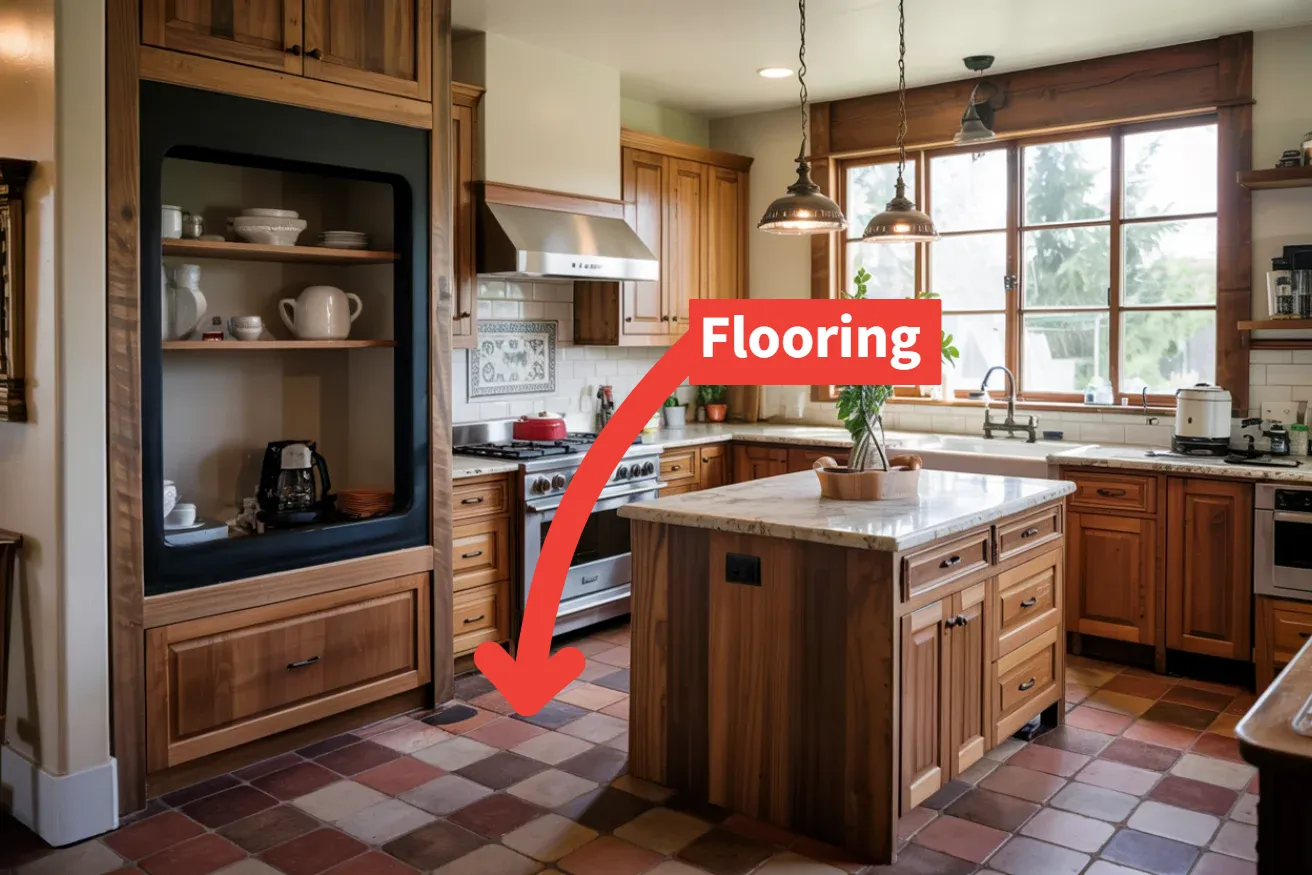
Kitchen flooring lives a hard life. It endures dropped pots, spilled liquids, temperature fluctuations, and constant foot traffic. Your flooring choice must balance beauty, practicality, and budget—no small feat.
Hardwood brings timeless warmth and character that integrates beautifully with many design styles. Costs typically range from $6 to $12 per square foot for new installation.
The appeal is undeniable—hardwood creates a seamless flow with adjacent living spaces and adds inherent value. The downside? It requires more maintenance than some alternatives and can be susceptible to water damage without proper sealing.
If you already have hardwood floors, refinishing costs only $3 to $4 per square foot—a bargain compared to new installation. Engineered hardwood provides enhanced stability and potentially better moisture resistance than solid hardwood.
Tile (Ceramic/Porcelain) offers unmatched durability and water resistance. Available in countless designs, colors, and sizes, tile provides endless creative possibilities.
Expect to pay $5 to $15 per square foot for quality tile installation. For high-traffic kitchens, consider quarry tile—an unglazed ceramic tile celebrated for its exceptional durability and inherent slip resistance. Its grout lines actually improve traction by channeling water away from the surface.
Tile can feel cold and hard underfoot, though heated floor systems can address this concern (at additional cost). Proper subfloor preparation is essential for preventing future cracking or loose tiles.
Luxury Vinyl Tile/Plank (LVT/LVP) has revolutionized kitchen flooring by combining convincing wood or stone looks with practical benefits. These products effectively mimic natural materials while offering superior water resistance.
Costs start around $1-$5 per square foot, making LVT/LVP an attractive option for budget-conscious remodels. For durability, look for solid vinyl where the color runs through the entire tile rather than just a printed surface layer.
The performance varies significantly between products. Look for certifications to ASTM F970 (static load resistance), ASTM F2199 (dimensional stability), and ANSI A326.3 (slip resistance) to ensure quality.
Natural Stone like marble, slate, or travertine delivers unmatched luxury and uniqueness. Each stone floor tells a geological story that can’t be replicated.
Premium pricing follows, with costs generally ranging from $15 to $30 per square foot. Slate flooring alone can add up to $32,000 for a large kitchen.
Stone requires specific maintenance depending on type, and certain varieties can be porous without proper sealing. The investment buys both beauty and bragging rights—natural stone floors often become a home’s signature feature.
Flooring typically accounts for around 7% of your kitchen remodel budget, though some estimates place the range higher at 7-15%. Installation costs generally run $10-$15+ per square foot beyond material costs.
Performance assessment relies on specific ASTM standards for critical properties:
Wear resistance (how well the surface withstands foot traffic) is measured by standards like ASTM F410 for resilient flooring and ASTM C1353 for stone and tile.
Water resistance matters enormously in kitchens. For installation over concrete, ASTM F2170 measures internal slab humidity using probes, while ASTM F1869 assesses moisture vapor emission from the surface.
Slip resistance might be the most critical safety factor. ANSI A326.3 measures Dynamic Coefficient of Friction (DCOF), with recommended minimum values of ≥0.42 for level interior floors that might get wet.
Dimensional stability (ASTM F2199) shows how much resilient flooring might expand, contract, or curl when exposed to heat—crucial near dishwashers and ovens.
The extensive catalog of testing standards for manufactured flooring (compared to fewer for natural materials) suggests that performance of products like vinyl and laminate depends heavily on manufacturing quality rather than inherent properties. When choosing these products, documented compliance with ASTM standards provides objective quality verification beyond visual appeal.
Other Components
Beyond the big three—countertops, cabinets, and flooring—several other elements significantly impact your kitchen’s functionality, appearance, and budget. Let’s explore the unsung heroes of kitchen design.
Appliances represent a major cost category, typically consuming around 14% of your remodel budget. The price range is staggering: from $1,000 for basic replacements to over $50,000 for a suite of high-end, integrated models.
Average spending hovers around $3,800, though ranges like $4,500-$24,700 better represent full replacements in mid-to-upscale projects. Your choices here dramatically affect both function and aesthetics.
Basic remodels typically include standard-grade appliances, mid-range projects feature mid-grade stainless steel, while luxury renovations incorporate built-in, integrated, or commercial-style appliances.
Current trends include smart appliances controllable via phone or voice and a growing preference for induction cooktops. Boulder’s environmentally conscious homeowners often prioritize energy efficiency, creating demand for appliances that minimize resource consumption.
Lighting accounts for about 5% of your kitchen budget but delivers outsized impact on both function and atmosphere. Total costs range from $50 for simple fixture replacements to $20,000+ for complex, layered lighting schemes requiring significant electrical work.
Modern kitchens benefit from thoughtful lighting strategies that combine ambient illumination (general brightness), task lighting (focused illumination for work areas), and accent lighting (decorative elements that create mood).
Smart lighting systems offering features like motion detection, voice activation, and programmable scenes have moved from luxury to mainstream. The ability to transition from bright task lighting while cooking to subtle ambient lighting during dinner transforms how you experience your kitchen.
Plumbing and Faucets typically represent 4-6% of your budget. Faucet costs alone range from $100 to $600+, depending on material, design, and features.
Total costs for plumbing work and fixtures typically run between $2,500-$7,000, potentially climbing to $2,000-$20,000 if you’re relocating plumbing lines. Moving gas or water lines significantly increases complexity and cost.
Touchless faucets have gained remarkable popularity, adding convenience and improving hygiene. Once considered a luxury feature, they’ve become increasingly standard in mid-range and higher remodels.
Backsplash allocations hover around 5% of your budget but offer extraordinary design opportunity. Total costs typically range between $1,900 and $4,500.
Common materials include ceramic tile ($5-$15/sq ft), glass tile ($7-$30/sq ft), and natural stone tile ($6-$20/sq ft). Current trends favor bold designs, patterned tiles, or natural stone slabs that serve as artistic focal points.
The backsplash offers a strategic opportunity for personal expression even in otherwise conservative kitchens. Since it occupies relatively little square footage, splurging on a distinctive backsplash often delivers significant visual impact without breaking the bank.
While these components individually represent smaller budget allocations than cabinets or countertops, their collective impact is substantial. The choices you make regarding appliances, lighting, plumbing fixtures, and finishes significantly influence both daily functionality and aesthetic cohesion.
Boulder’s design sensibilities increasingly favor energy-efficient appliances and fixtures that align with local sustainability values. This isn’t just environmental virtue signaling—efficient choices translate to real utility savings over time, particularly valuable in a region with rising energy costs.
Boulder Permitting Requirements
Think permits are just bureaucratic red tape? Think again. They’re essential safeguards that ensure your beautiful new kitchen won’t burn down your house or collapse into your basement. Let’s navigate Boulder’s specific requirements.
When a Permit is Required
The City of Boulder Planning & Development Services requires permits for kitchen remodeling work that modifies the building’s structure or major systems. Here’s what triggers the need for permits:
Structural Changes require permits. Moving, removing, or modifying walls (especially load-bearing walls) or changing the building’s framing? You’ll need official approval.
Electrical Work almost always requires permits. Adding new circuits, relocating outlets or switches, or installing new lighting fixtures with wiring modifications all necessitate proper electrical permits.
Plumbing Work changes need oversight too. Relocating water supply lines or drain pipes, or adding new fixtures like a pot filler or island sink that extend existing plumbing? That requires a plumbing permit.
Gas Systems modifications are closely regulated. Any work involving changes to natural gas lines—often needed when relocating a gas range or adding a new gas appliance—requires permitting.
Mechanical/HVAC alterations fall under scrutiny as well. Modifying ductwork for range hoods or changing ventilation paths typically require mechanical permits.
What doesn’t need permits? Minor cosmetic updates usually get a pass. Tasks like replacing cabinets or countertops in their existing locations without altering plumbing or electrical connections, painting walls, or installing new flooring over existing subfloor generally don’t require permits.
When in doubt, contact Planning & Development Services. The consequences of skipping required permits can be severe: stop-work orders, financial penalties, insurance coverage complications, and significant headaches when selling your property.
The permit requirements effectively necessitate professional involvement for nearly all remodels beyond simple cosmetic changes. While homeowners can sometimes act as their own general contractor, they must still demonstrate code knowledge, pass inspections, and often hire licensed subcontractors for specialized work.
This regulatory framework contributes significantly to the higher costs associated with mid-range and major remodels compared to minor, cosmetic-only projects. It’s not just about materials and design—it’s about ensuring safety and compliance with established codes.
Application Process and Documentation
Boulder has gone entirely digital with its permitting process. All submissions must be made through the city’s Customer Self-Service (CSS) Portal. Here’s the typical workflow:
- Registration and Preparation: Create an account on the CSS Portal. Before applying, gather property-specific information such as zoning details and permit history. Clearly identify your project scope to determine necessary permit types.
- Plan Preparation: Your application requires detailed plans illustrating all proposed work. These must be drawn to scale (minimum 1/4″ = 1′-0″) and demonstrate compliance with Boulder County Building Code Amendments and relevant Land Use Codes. For projects altering conditioned floor area, you’ll need details showing compliance with Boulder County BuildSmart energy efficiency regulations.
- Submission: Upload your completed application and all required plans (in PDF format) through the CSS Portal.
- Fee Payment: Pay applicable permit fees, typically online through the portal (though service fees may apply for credit card transactions).
- Review Process: City staff will review your application and plans. This can take several weeks depending on project complexity and departmental workload. You can monitor application status through the CSS Portal dashboard.
- Permit Issuance: Upon approval, you can download the official permit placard and approved plans from the CSS Portal. These documents must be readily available on your job site for inspectors.
This digital process requires familiarity with the online portal system. Incomplete or inadequate documentation leads to delays or rejection, so thorough preparation is essential. Factor the potentially multi-week review period into your project timeline.
The mandatory use of the digital submission system combined with requirements for detailed, code-compliant plans creates an environment that inherently favors experienced contractors or homeowners with access to professional design services. While intended to streamline the process, this system can challenge those less comfortable with digital platforms or attempting complex projects without professional documentation.
Associated Fees and Taxes
Several fees and taxes accompany building permits for kitchen remodels in Boulder:
Permit Fees are calculated based on project valuation. While Boulder publishes its fee schedule annually, Denver examples provide insight into the structure: projects valued $2,001-$25,000 might incur a base fee plus a charge per $1,000 of value over $2,000; projects $25,001-$50,000 have a higher base fee plus a charge per $1,000 over $25,000.
A typical residential interior remodel permit package includes fees for Building Plan Check, the main Building Permit, and separate permits for Electrical, Mechanical, and Plumbing work as applicable. Total permit costs for kitchen remodels typically range from $200 to $2,500, depending on scope.
Sales and Use Taxes apply to materials purchased for the remodel and potentially certain labor components.
Other Potential Fees may include charges for reinspections if initial inspections fail (approximately $100/hour) or for requesting inspections outside normal business hours. Credit card payments through the city’s system typically incur service fees.
While permit fees may not dominate your budget for high-value remodels, they represent a necessary line item in your financial planning. The practice of calculating fees based on project valuation creates a dynamic where higher project costs directly increase permit fees.
Local Codes and Inspections
All permitted construction work in Boulder must adhere to the currently adopted local building codes, including Boulder County Building Code Amendments and relevant sections of the Land Use Code. For projects changing conditioned (heated or cooled) space, compliance with Boulder County’s BuildSmart energy efficiency regulations is mandatory.
A critical component of the permitting process is the series of inspections conducted by city officials. These inspections verify work is performed correctly and meets code requirements before being concealed—for example, checking electrical wiring and plumbing pipes before drywall installation.
Inspections are scheduled through the online CSS Portal. The approved plans and permit placard must be present and accessible on the job site during each inspection. Some inspections may require prerequisite documentation or reports to be uploaded to the portal before they can be passed.
Code adherence isn’t optional—it ensures safety, legality, and long-term value. Inspections serve as quality control checkpoints throughout construction. Failing an inspection can lead to project delays, as work must be corrected and reinspected before proceeding, potentially increasing costs through rework and lost time.
The requirement for multiple inspections at specific milestones introduces significant logistical complexity. Careful scheduling and coordination are essential between your general contractor, various trade subcontractors (electricians, plumbers, etc.), and the city’s building inspection department.
Work often must pause at specific phases pending inspection approval, creating potential bottlenecks. Delays can arise from inspector scheduling availability or from failed inspections requiring correction and re-inspection. Such delays ripple through the entire project timeline, potentially increasing costs through crew downtime, extended project duration, and rework expenses.
Effective management of the inspection sequence proves critical to maintaining project schedules and budgets. Experienced contractors develop strategies to minimize these bottlenecks, sometimes scheduling multiple inspections for the same day when possible or ensuring work is thoroughly prepared before requesting inspections.
Contractor Licensing
Boulder mandates that contractors performing permit-required work must hold a valid license issued specifically by the city. This applies to General Contractors (Class A, B, or C, depending on project scope), Electrical Contractors, Plumbing Contractors, and Mechanical Contractors.
Homeowners working on their primary residence may qualify for exemption from contractor licensing requirements but typically must apply for a specific Homeowner Contractor License. Even when exempt, homeowners remain fully responsible for ensuring code compliance and passing inspections.
To obtain a General Contractor license in Boulder, applicants must:
- Complete the official City of Boulder Contractor License Application
- Provide proof of passing the relevant International Code Council (ICC) examination
- Submit current Certificate of Insurance with required coverage levels
- Pay annual licensing fees as stipulated in the Boulder Revised Code
- Applicants for Class A or B licenses may need to provide additional qualification information
Crucially, Boulder does not offer reciprocity—licenses from other jurisdictions aren’t accepted as substitutes for Boulder-specific credentials.
Using properly licensed and insured contractors provides essential protection for homeowners. Before hiring any contractor for permit-required work, verify they hold a current and valid Boulder-specific license for the type of work being performed.
Boulder’s strict, non-reciprocal licensing policy potentially influences the local construction market. By not recognizing licenses from adjacent areas like Denver or Longmont, the city effectively requires non-local contractors to navigate the full local licensing process to legally operate in Boulder.
This may limit the pool of available licensed contractors compared to areas with reciprocity agreements. Basic economics suggests that constrained supply relative to demand can contribute to higher service prices. The policy also places greater administrative burden on companies operating across multiple nearby municipalities, potentially favoring firms focused primarily within Boulder.
This market structure could contribute to the higher labor costs observed in the area, further amplifying Boulder’s already premium remodeling prices.
Planning & Development Services Contact
For inquiries regarding building permits, inspections, zoning, contractor licensing, or other related matters, contact the Planning & Development Services (P&DS) Department:
- Phone: 303-441-1880
- Address: 1101 Arapahoe Avenue, Boulder, CO 80302
- Public Service Hours: Tuesday – Friday, 10:00 am to 4:00 pm
- Website: Access information, forms, and the CSS Portal through the City of Boulder’s official website (bouldercolorado.gov)
This contact information allows homeowners and contractors to engage directly with the relevant city department for requirement clarification, procedural questions, application status checks, or issue resolution.
Boulder-Specific Market Influences
Why does Boulder’s remodeling market command such premium prices? Several factors unique to this area create a perfect storm for elevated costs.
Local Labor Rates
Labor costs represent a major driver of Boulder’s remodeling expenses, with wages significantly exceeding national benchmarks.
The mean hourly wage across all occupations in the Boulder Metropolitan Statistical Area reached $41.93 in May 2023—substantially above the U.S. average of $31.48. This sets the foundation for a high-cost labor environment.
For construction specifically, the “Construction and Extraction Occupations” category averaged $30.40 hourly in Boulder as of May 2023, modestly exceeding the national average of $29.57.
Drilling deeper reveals more nuance. Job posting sites report average hourly pay for a “Construction Worker” in Boulder around $26, with top earners near $29. The average for a “General Contractor” employee role hovers around $32/hour, with top earners reaching $50/hour.
Compensation data aggregators suggest even higher figures for established contractors: one source reports contractor salaries equivalent to $71/hour, while another lists high six-figure salaries for construction management roles. General contractor company fees charged to clients typically range between $50 and $150 per hour.
Skilled trades command premium rates, particularly in union or prevailing wage contexts: Electricians at $43.20/hour plus benefits, Plumbers at $42.98/hour plus benefits, and Ironworkers at $37.23/hour plus benefits.
Boulder’s local minimum wage ($15.57/hour as of Jan 2025) sets a floor but has less relevance for skilled trades.
These consistently high wages across various sectors, clearly reflected in construction roles, drive elevated remodeling costs compared to national figures. Since labor constitutes a substantial portion of the total project budget (potentially 30-40%), this wage premium significantly impacts bottom-line costs.
The combination of high prevailing wages, substantial reported salaries for experienced contractors, and Boulder’s potentially restricted contractor pool due to non-reciprocal licensing rules creates a market where skilled construction labor commands significant premiums.
Boulder Area Construction Labor Rate Ranges
| Role | Estimated Hourly Wage/Rate Range ($) | Notes |
|---|---|---|
| General Laborer / Construction Worker | $18 – $29 | Based on BLS mean for broader category, ZipRecruiter percentiles. City minimum wage $15.57. |
| Carpenter | $23 – $40+ | Based on limited prevailing wage data and general construction wage levels. Skilled non-union rates likely vary significantly. |
| Electrician (Licensed) | $40 – $70+ | Reflects union/prevailing wage data and likely market rates for licensed professionals. |
| Plumber (Licensed) | $40 – $70+ | Reflects union/prevailing wage data and likely market rates for licensed professionals. |
| General Contractor (Company Rate) | $75 – $150+ | Estimated rate charged to client, covering overhead, insurance, management, profit, etc. Based on reported fee ranges and salary data. |
Ranges represent synthesized estimates from various sources. Actual rates vary based on experience, project complexity, employer, and negotiation.
Material Availability and Sourcing
Boulder’s material supply chain combines national distribution networks with local sustainability priorities, creating a distinctive sourcing landscape.
The region benefits from both large national building material suppliers like Builders FirstSource and local or regional distributors such as Western Building Supply. Specialized kitchen design firms often act as suppliers for key components like cabinetry.
Like elsewhere, Boulder’s construction industry remains vulnerable to broader supply chain disruptions. Events like natural disasters, economic downturns, or labor shortages can impact material availability and pricing. Past material cost spikes have directly affected local remodelers.
The concept of “regional construction capacity”—the local industry’s ability to supply materials and labor to meet demand—becomes particularly relevant during unexpected demand surges. Research at the University of Colorado Boulder specifically studies these regional supply chain dynamics.
What distinguishes Boulder’s market is its pronounced emphasis on sustainability. Boulder County actively promotes construction and demolition (C&D) waste recycling, targeting materials like metals, wood, concrete, asphalt, and roofing shingles. The county also encourages reuse of salvaged building materials like cabinets, doors, fixtures, and clean lumber.
This sustainability focus appears in both business offerings and consumer preferences. Local businesses specializing in sustainable building materials thrive, and homeowners increasingly request eco-friendly materials in their remodels.
While standard construction materials remain readily available through established channels, the county’s emphasis on sustainability adds another dimension to material selection. This influences choices toward recycled content, reclaimed materials, or products with lower environmental impact.
The Boulder material sourcing landscape appears robust, with diverse options from national distributors to specialized local suppliers. Navigating this environment often involves balancing traditional material sources against sustainability goals, sometimes favoring suppliers who facilitate recycling or offer certified eco-friendly products.
Common Design Preferences and Trends
Boulder kitchens reflect a distinctive blend of modern aesthetics, functionality, natural elements, and sustainability consciousness.
Layout and Spatial Design preferences lean heavily toward open-concept floor plans. Removing walls to merge kitchens with adjacent living spaces creates a sense of spaciousness and reinforces the kitchen’s role as a gathering hub.
Central to many Boulder kitchens is a large, multifunctional island serving as preparation space, casual dining area, and social focal point. These islands often incorporate substantial storage and sometimes feature different counter materials than the perimeter.
Dominant Styles in Boulder kitchens balance contemporary aesthetics with warmth. “Soft minimalism” tempers minimalist principles with natural materials, muted color palettes, and organic textures, creating serene yet inviting spaces.
Another prevalent trend is “modern organic,” emphasizing nature’s beauty through wood, stone, abundant natural light, plants, and eco-friendly materials. This approach celebrates natural textures and imperfections while maintaining clean lines.
Materials and Finishes reflect these stylistic preferences. Natural materials—particularly wood (including reclaimed varieties) and stone—dominate Boulder kitchens.
Eco-friendly choices, such as low-VOC finishes and sustainably sourced materials, align with local environmental values. Quartz and granite remain common countertop choices, while two-tone cabinet schemes—often combining natural wood with painted sections—add visual interest.
Backsplashes increasingly make bold statements through patterns, unique tile shapes, or natural stone slabs. Some Boulder homes incorporate distinctive finishes like natural clay plaster walls for a truly unique aesthetic.
Functionality and Technology Integration balance traditional craftsmanship with modern innovation. Boulder kitchens prioritize efficient organization and ample storage to maintain clutter-free environments.
Smart home technology integration continues to grow, with features like touchless faucets, smart appliances controllable via apps, and sophisticated lighting systems becoming increasingly common. Induction cooktops gain popularity
Functionality and Technology Integration balance traditional craftsmanship with modern innovation. Boulder kitchens prioritize efficient organization and ample storage to maintain clutter-free environments.
Smart home technology integration continues to grow, with features like touchless faucets, smart appliances controllable via apps, and sophisticated lighting systems becoming increasingly common.
Induction cooktops gain popularity due to their speed, energy efficiency, and safety benefits. There’s also growing focus on wellness-oriented features: larger, more flexible refrigeration for fresh foods and appliances offering healthier cooking methods like steam or air frying.
The quest for a serene kitchen environment drives demand for ultra-quiet dishwashers and soft-close mechanisms for cabinets and drawers. Effective lighting design, employing layers of ambient, task, and decorative lighting, remains essential for both functionality and atmosphere.
These trends encapsulate Boulder’s distinctive lifestyle: connection to nature, commitment to sustainability, appreciation for technology, and desire for spaces that support both cooking and social interaction. Understanding these preferences guides creating kitchens that satisfy personal needs while maintaining appeal in the local real estate market.
The convergence toward natural materials, enhanced functionality via islands and smart tech, and specific aesthetics like soft minimalism creates a well-defined blueprint for high-demand Boulder kitchens.
Projects diverging significantly from these patterns—featuring ornate traditional elements, heavy synthetic materials, or ignoring sustainability—might appear less aligned with local tastes, potentially impacting future resale value even if beautifully executed.
Conclusion
So what’s the bottom line for your Boulder kitchen remodel?
Expect to invest $20,000-$35,000 for minor updates, $60,000-$150,000 for mid-range renovations, or $150,000-$300,000+ for upscale transformations. And here’s the twist: those modest facelifts often return 90%+ of their cost, while those stunning chef’s kitchens might return just 35-55%.
Where will your money go? Nearly a third disappears into cabinetry alone, with labor and appliances consuming another third combined.
Boulder’s unique market demands careful navigation: stringent permitting, non-reciprocal contractor licensing, and sky-high labor rates create challenges that your budget must accommodate.
But there’s good news. Boulder kitchens now embrace a distinctive aesthetic merging contemporary clean lines with natural materials and smart technology. This convergence means even moderately priced remodels can deliver spaces that feel both timeless and distinctly “Boulder.”
The path to your dream kitchen isn’t cheap—but with strategic choices, it can be worth every penny.
